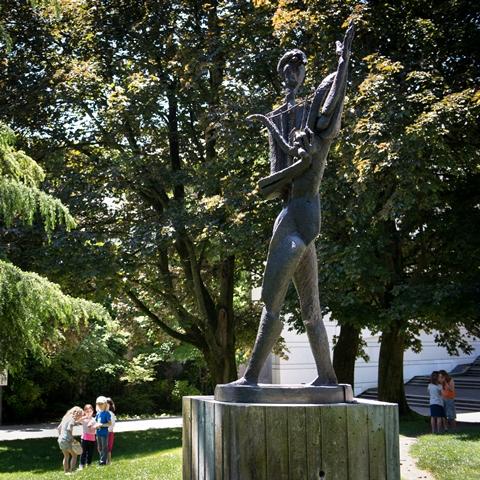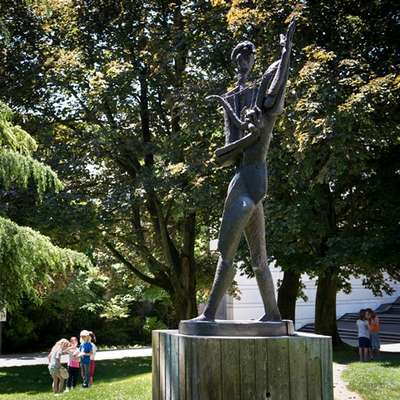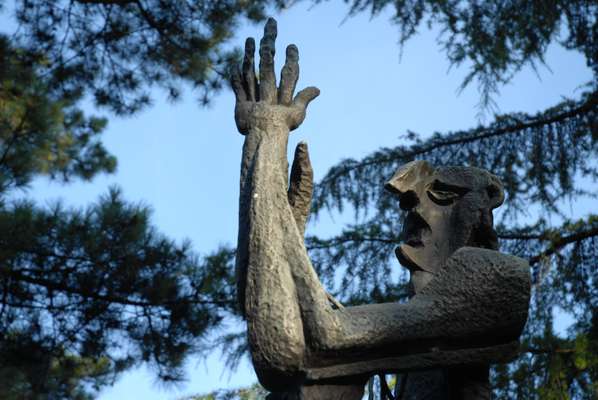
Orphée, Ossip ZADKINE

Orpheus, 1948, Sculpture made from bronze with patina.
Situated in Albert Michallon Park, the sculpture represents Orpheus "in profile like a proud bird", split down the middle with the lyre and its chords seemingly bursting out of this divide. His right hand, fixed onto the end of a forearm detached from the shoulder, is holding the instrument whilst the left hand seems to be waving to us. Hollows and niches create a multitude of planes inscribing this work firmly in the cubist lineage. In his text "the mallet and the chisel" written in 1968, the artist tells how after having finished this "Orpheus", he discovered a piece of wood in the shape of a double fork resembling his sculpture. He kept it in his workshop until he died. The characters that inspired ZADKINE were more often than not taken from great universal myths such as the first Orpheus made from elm wood between 1928 and 1930. He made 6 other versions, the last one dating to 1961.
A sculptor of Russian origin, ZADKINE (1890 - 1967) came to Paris in 1909 to perfect his art. His passion for direct sculpting made him one of the main representatives of the technique that saw a revival in the early twentieth century. After having been influenced by cubism, he became interested in Greek and Roman statuary, African art, or furthermore Romanesque and Gothic forms. ZADKINE is well-represented in the Musée de Grenoble collection with The Faun and The Head of a Young Girl bought in 1921 by ANDRY- FARCY, Woman’s Torso acquired in 1933 and finally The Prophet, donated in 1938 by the artist himself.
This work has been on loan from the National Foundation for Contemporary Art since 1994 The town of Grenoble has more than 150 works installed in public places that we invite you to discover thanks to several trails across the town and on the grenoble-patrimoine.fr website. These trails have been created with the help of the Département of Isère and the Auvergne-Rhône Alpes Regional Cultural Affairs Directorate.
Située dans le parc Albert Michallon, cette sculpture en bronze patiné représente Orphée "au fier profil d'oiseau", fendu en deux, d'où jaillit la lyre et son faisceau de cordes. La main droite, fixée au bout d'un avant-bras décroché de l'épaule, tient l'instrument tandis que la gauche semble esquisser un salut. Évidements et décrochements créent une multiplication des plans qui inscrit l'œuvre dans la lignée du cubisme. Dans son texte Le maillet et le ciseau écrit en 1968, l'artiste raconte qu'après avoir achevé cet Orphée, il découvre un morceau de bois en forme de double fourche ressemblant à sa sculpture, qu’il conserva dans son atelier jusqu'à sa mort. Les personnages qui inspirent ZADKINE sont le plus souvent empruntés aux grands mythes universels, tel un premier Orphée en bois d'orme réalisé entre 1928 et 1930. Il en fera six autres versions, la dernière datant de 1961.
Sculpteur d'origine russe, ZADKINE (1890 - 1967) arrive à Paris en 1909 pour parfaire sa pratique. Son engouement pour la taille directe en fait l'un des représentants majeurs de cette technique remise à l'honneur au début du XXe siècle. Après avoir subi l'influence du Cubisme, il s'intéresse tour à tour à la statuaire grecque et romaine, à l'art africain, ou encore aux formes romanes et gothiques. ZADKINE est admirablement représenté dans la collection du musée de Grenoble avec Le Faune et Tête de jeune fille achetés en 1921 par ANDRY-FARCY, Torse de femme acquis en 1933 et enfin Le Prophète, offert en 1938 par l'artiste lui-même.
Cette œuvre est un dépôt du Fonds National d’Art Contemporain en 1994. La Ville de Grenoble compte plus de 150 œuvres implantées sur l’espace public, que nous vous invitons à découvrir à travers plusieurs parcours dans la ville et sur le site grenoble-patrimoine.fr. Ces parcours ont été réalisés avec l’aide du Département de l’Isère et de la Direction Régionale des Affaires Culturelles Auvergne-Rhône Alpes.
Parcours associé
Période historique
6ème période : 1925 / 1968Classé en
- Patrimoine Monumental (Artistique, culturel et scientifique)
Thématique(s)
- Art et culture
En savoir plus
En liaison avec cet élément du patrimoine
Bibliographie
- www.museedegrenoble.fr- Un musée sans murs, la commande publique dans l'agglomération grenobloise depuis les années 50. - Grenoble, CNAC et Musée dauphinois, 1999.










